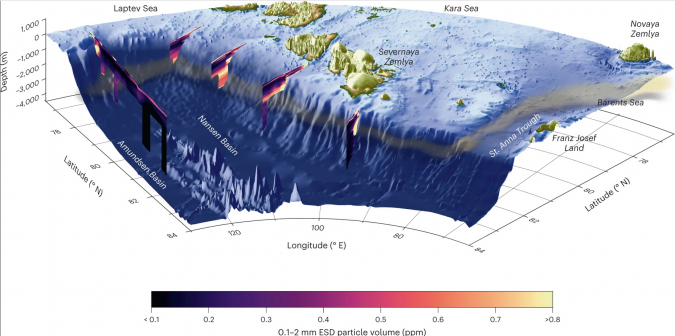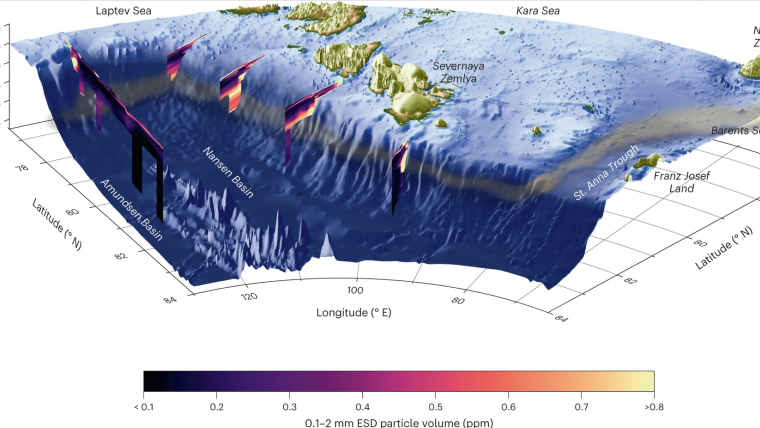Researchers Discover Arctic Carbon Conveyor Belt
Researchers have found a new transport route for carbonaceous material from productive Arctic marginal seas to the deep sea. In light of this newly discovered mechanism, the Barents Sea would appear to effectively remove roughly 30% more carbon from the atmosphere than previously thought.
Every year, the cross-shelf transport of carbon-rich particles from the Barents and Kara Seas could bind up to 3.6 million metric tons of CO2 in the Arctic deep sea for millennia. In this region alone, a previously unknown transport route uses the biological carbon pump and ocean currents to absorb atmospheric CO2 on the scale of Iceland’s total annual emissions, report researchers from the Alfred Wegener Institute and partner institutes in the current issue of Nature Geoscience.
Water-Mass Transport
Compared to other oceans, the biological productivity of the central Arctic Ocean is limited, since sunlight is often in short supply – either due to the polar night or sea-ice cover – and the available nutrient sources are scarce. Consequently, microalgae (phytoplankton) in the upper water layers have access to less energy than their counterparts in other waters. The surprise was therefore great when, on the ARCTIC2018 expedition in August and September 2018 on board the Russian research vessel Akademik Tryoshnikov, large quantities of particulate carbon – i.e. stored in plant remains – were discovered in the Nansen Basin of the central Arctic. Subsequent analyses revealed a body of water with large amounts of particulate carbon to depths of up to two kilometres, composed of bottom water from the Barents Sea. This is produced when sea ice forms in winter, then cold and heavy water sinks and subsequently flows from the shallow coastal shelf down the continental slope and into the deep Arctic Basin.
“Based on our measurements, we calculated that through this water-mass transport, more than 2,000 metric tons of carbon flow into the Arctic deep sea per day, the equivalent of 8,500 metric tons of atmospheric CO2. Extrapolating to the total annual amount revealed even 13.6 million metric tons of CO2, which is on the same scale as Iceland’s total annual emissions,” explained Dr Andreas Rogge, first author of the Nature Geoscience study and oceanographer at the Alfred Wegener Institute, Helmholtz Centre for Polar and Marine Research (AWI). This plume of carbon-rich water spans the Barents and Kara Sea shelves to roughly 1,000 kilometres into the Arctic Basin. In light of this newly discovered mechanism, the Barents Sea – already known to be the most productive marginal sea in the Arctic – would appear to effectively remove roughly 30% more carbon from the atmosphere than previously thought. Moreover, model-based simulations showed that the outflow manifests in seasonal pulses, since the absorption of CO2 by phytoplankton only takes place in summer in the Arctic’s coastal seas.
Deep-sea Sediments
Understanding transport and transformation processes within the carbon cycle is essential for creating global CO2 budgets and projections for global warming. On the ocean’s surface, single-celled algae absorb CO2 from the atmosphere and sink towards the deep sea when they die. Once carbon bound in this manner reaches the deep water, it stays there until overturning currents bring the water back to the ocean’s surface, which takes several thousand years in the Arctic. If the carbon is deposited in deep-sea sediments, it can even be trapped for millions of years, only being released by volcanic activity. This process, also known as the biological carbon pump, can remove carbon from the atmosphere for long periods of time and represents a vital sink in our planet’s carbon cycle. The process also represents a food source for local deep-sea fauna such as starfish, sponges and worms. The percentage of the carbon actually absorbed by the ecosystem should be addressed in future research.
The polar shelf seas harbour other largely unexplored regions in which bottom water is formed and flows into the deep sea. As such, it can be assumed that the global influence of this mechanism as a carbon sink is actually much greater. “However, due to the ongoing global warming, less ice and therefore less bottom water is formed. At the same time, more light and nutrients are available for the phytoplankton, allowing more CO2 to be bound. Accordingly, it’s currently impossible to predict how this carbon sink will develop, and the identification of potential tipping points urgently calls for additional research,” stated Andreas Rogge.















